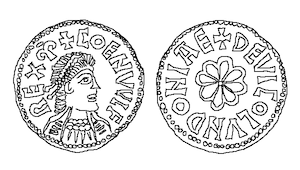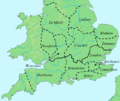Coenwulf of Mercia facts for kids
Quick facts for kids Coenwulf |
|
|---|---|

Coenwulf's portrait from the "Coenwulf mancus", a gold coin discovered in Bedfordshire in 2001.
|
|
| King of Mercia | |
| Reign | 796–821 |
| Predecessor | Ecgfrith |
| Successor | Ceolwulf I |
| Died | 821 Basingwerk, Flintshire |
| Spouse | Cynegyth (possibly) Ælfthryth |
| Issue | Cynehelm Cwoenthryth |
| House | C-dynasty |
| Father | Cuthberht |
Coenwulf (also spelled Cenwulf and Kenulf) (died 821) was a Mercian nobleman and the King of Mercia from December 796 until his death. He claimed to be a descendant of a Cenwalh, a brother of Penda and Eowa. The sudden death of King Ecgfrith of Mercia was suspicious and certainly benefited Coenwulf but he was never formally accused. Coenwulf proved to be a strong king who quickly restored Mercian in southern England. He was the last of the Mercian overlords or .
Background and sources
For most of the 8th century, Mercia was dominant among the Anglo-Saxon kingdoms south of the river Humber. Æthelbald, who came to the throne in 716, had established himself as the overlord of the southern Anglo-Saxons by 731. He was assassinated in 757, and was briefly succeeded by Beornred, but within a year Offa ousted Beornred and took the throne for himself. Offa's daughter Eadburh married Beorhtric of Wessex in 789, and Beorhtric became an ally thereafter. In Kent, Offa intervened decisively in the 780s, and at some point became the overlord of East Anglia, whose king, Æthelred, was executed on Offa's orders in 794.
Offa appears to have moved to eliminate dynastic rivals to the succession of his son, Ecgfrith. Ecgfrith succeeded him but reigned for less than five months before Coenwulf came to the throne.
Reign
According to the Anglo-Saxon Chronicle, Ecgfrith only reigned for 141 days. Offa is known to have died in 796, on either 26 July or 29 July, so Ecgfrith's date of death is either 14 December or 17 December of the same year. Coenwulf succeeded Ecgfrith as king.
Coenwulf's kin may have been connected to the royal family of the Hwicce, a subkingdom of Mercia around the lower river Severn. It appears that Coenwulf's family were powerful, but they were not of recent Mercian royal lineage.
In the early years of Coenwulf's reign he had to deal with a revolt in Kent, which had been under Offa's control. Eadberht Præn returned from exile in Francia to claim the Kentish throne. Coenwulf was unwilling to take military action in Kent without acknowledgement from Pope Leo III that Eadberht was a pretender. The basis for this assertion was that Eadberht had reportedly been a priest, and as such had given up any right to the throne. Coenwulf wrote to the Pope and asked Leo to consider making London the seat of the southern archbishopric, removing the honour from Canterbury. Leo refused to agree to moving the archiepiscopate to London, but in the same letter he agreed that Eadberht's previous ordination made him ineligible for the throne. Coenwulf then invaded Kent and retook the kingdom; Eadberht was taken prisoner and blinded.
Coenwulf also appears to have lost control of the kingdom of East Anglia during the early part of his reign, as an independent coinage appears under King Eadwald. Coenwulf's coinage reappears in 805, indicating that the kingdom was again under Mercian control. Several campaigns of Coenwulf's against the Welsh are recorded, but only one conflict with Northumbria, in 801, though it is likely that Coenwulf continued to support the opponents of the Northumbrian king Eardwulf.
Coenwulf came into conflict with Archbishop Wulfred of Canterbury over the issue of whether laypeople could control religious houses such as monasteries. The breakdown in the relationship between the two eventually reached the point where the archbishop was unable to exercise his duties for at least four years. A partial resolution was reached in 822 with Coenwulf's successor, King Ceolwulf, but it was not until about 826 that a final settlement was reached between Wulfred and Coenwulf's daughter, Cwoenthryth, who had been the main beneficiary of Coenwulf's grants of religious property.
Coenwulf died in 821 at Basingwerk near Holywell, Flintshire, probably while making preparations for a campaign against the Welsh that took place under his brother and successor, Ceolwulf, the following year. Coenwulf's body was moved to Winchcombe where it was buried in St Mary's Abbey (later known as Winchcombe Abbey).
Coenwulf was succeeded by his brother, Ceolwulf; a post-Conquest legend claims that his son Cynehelm was murdered to gain the succession. Within two years Ceolwulf had been deposed, and the kingship passed permanently out of Coenwulf's family. Coenwulf was the last king of Mercia to exercise substantial dominance over other Anglo-Saxon kingdoms. Within a decade of his death, the rise of Wessex had begun under King Egbert, and Mercia never recovered its former position of power.
A lead seal belonging to King Coenwulf was found during the 19th century in Italy. It is now in the British Museum.
Family
Coenwulf had two known children:
- Cynehelm (died 812), heir to the throne but died before his father.
- Cwenthryh, abbess of Winchcombe in Gloucestershire. Was thought to be involved in the murder of her brother Cynehelm.
Images for kids
See also
 In Spanish: Coenwulf de Mercia para niños
In Spanish: Coenwulf de Mercia para niños




